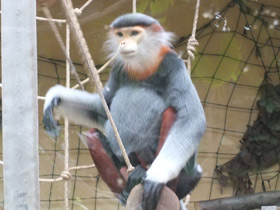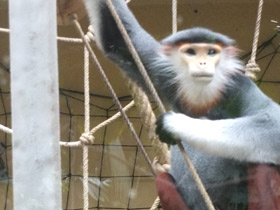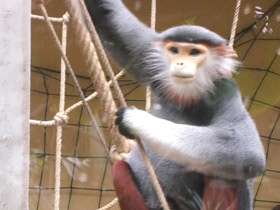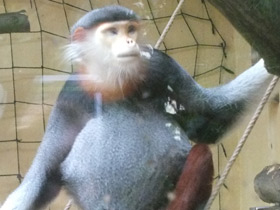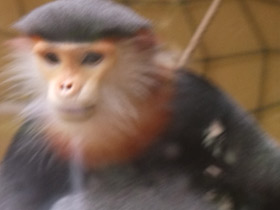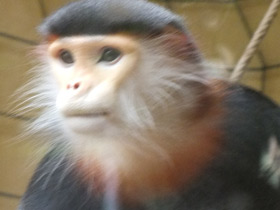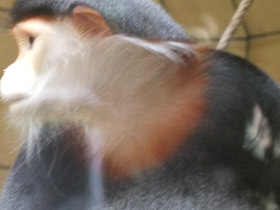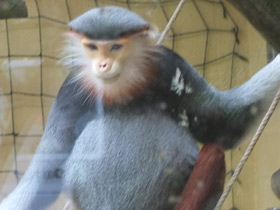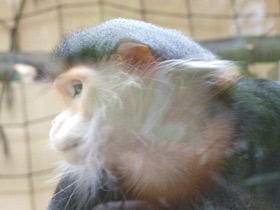The red-shanked douc (Pygathrix nemaeus)
 The red-shanked douc (Pygathrix nemaeus) included in the IUCN Red List as "endangered species"
The red-shanked douc (Pygathrix nemaeus) included in the IUCN Red List as "endangered species"
The red-shanked douc (Pygathrix nemaeus) is an arboreal and diurnal Old World monkey belonging to the Colobinae subfamily. They are endemic to Laos, Vietnam and Cambodia. They are known for their bright colours and express exhibit sexual dimorphism through their body size. The species have been declared critically endangered by the International Union for Conservation of Nature, with the main threats being from hunting, habitat loss and pet trade. They are one of three species in the genus Pygathrix, the other two being the black-shanked (P. nigripes) and gray-shanked (Pygathrix cinerea) doucs.
Red-shanked doucs live in fission-fusion, multilevel societies that have a mean of 18 individuals per band. They are folivorous and consume mainly Acacia pruinescens, Ficus racemosa, Millettia nigrescens, Zanthoxylum avicennae and Castanopsis ceratacantha. Their four-chambered stomachs that allow for bacterial fermentation help them with their high-fiber diet.
Appearance
Pygathrix nemaeus is a species of multicoloured catarrhine primate of the family Cercopithecidae.
Because of their extravagant appearance, these remarkable animals are often called "party monkeys", and in terms of sheer colourfulness only a handful of primates extant today can match them.
Pygathrix nemaeus has light to dark grey fur. From the knees to the feet it becomes a deep reddish-brown, and from the elbows to the hands white (hands and feet black). The muzzle of these monkeys is golden and framed by long white sideburns, much thicker in males. Smoky blue eyelids and a long tail with a white triangle at its base complete this colourful ensemble.
Females and males of Pygathrix nemaeus have almost no visual differences, except for two white spots on the sides of the rump. Both sexes reach a body length of 55-61 cm, but the tail is longer in males, 60-74 cm, and about 60 cm in females. Males weigh 11-12.6 kg, females 8.2-8.9 kg. Its tail is not of the grasping type and is used for balance during movement.
Habitat
Pygathrix nemaeus are native to Southeast Asia, and are common in northern and central Vietnam, Laos and probably northern Cambodia. Pygathrix nemaeus inhabit different forest types: lowland and montane forests at altitudes up to 2000 metres above sea level, deciduous forests, primary and secondary rainforests. They lead a diurnal lifestyle and spend most of their time in the middle and upper layers of the rainforest. They hardly ever descend to the ground, as they feed and sleep in the trees.
Lifestyle
To navigate along predetermined paths, the slender bill is aided by its tenacious limbs and long tail, which help it to maintain its balance. During large migrations, adult males always lead the group, with the youngest covering the rear, while females and young have a safe place in the centre of the column.
Pygathrix nemaeus are true aerial acrobats, extremely agile and with lightning-fast reactions. It is hard not to notice Pygathrix nemaeus walking under the trees: they literally fly from branch to branch, demonstrating a fantastic sense of balance. They use all four limbs when moving through the tree canopy and can leap up to six metres.
Pygathrix nemaeus feed mainly on leaves: their bicameral stomach is adapted to digest large amounts of cellulose. They tend to choose young, tender leaves, which can account for up to three-quarters of their diet. Fruit, shoots, flowers, bamboo shoots, seeds and nuts supplement their diet. Boobies do not drink water and obtain all the liquid they need from food.
Social behaviour
Like all monkeys, Pygathrix nemaeus are social and sociable creatures. They form groups of 4 to 15 individuals, sometimes forming herds of up to 50 animals. Females usually outnumber males by a factor of two. Both females and males have a strict hierarchy in the group, with males higher in the hierarchy than females.
Reproduction
The mating season of Pygathrix nemaeus lasts from February to June, when fruits ripen and food is abundant. Their mating ritual deserves special attention. Both partners eloquently demonstrate their readiness for mating by moving their jaws forward, wagging their eyebrows up and down and shaking their heads. The female takes the first step, resting her head on a branch and looking over her shoulder at her approaching mate. The male assesses the situation and approaches his mate and, if alarmed, takes her to another, safer place. Mating usually occurs every two years.
Pygathrix nemaeus gestations last between 165 and 190 days and have one, or rarely two, young in a litter. The fur of newborns is lighter than that of adults. Females reach sexual maturity at four years of age, males on average one year later. When they reach puberty, both usually leave their group. The longevity of these monkeys is up to 25 years.
Diet
Red-shanked doucs are highly folivorous. In the Son Tra Nature Reserve found they consume 54.8% buds and young leaves, 22.6% mature leaves, 3.7% leaf petioles and 18.9% other plant parts. Per month, they found that the red-shanked doucs consumed a mean of 18 species per month and a total of 226 species consumed altogether. Out of the 226 species, there are five species that were eaten 47-82% of the time: Acacia pruinescens, Ficus racemosa, Millettia nigrescens, Zanthoxylum avicennae and Castanopsis ceratacantha. Red-shanked doucs are selective feeders and flexible eaters because of their ability to eat a wide variety of food in all seasons. Fruit is consumed mainly in the morning, which is common amongst leaf-eating monkeys as this is where they derive their energy for the day.
They have different eating patterns during the wet season and the dry season both in what they eat and in the parts of the plants that they eat, although it is not a drastic change. Figs however, are consumed all year long and make up 16-36% of their diet. It is the second most commonly consumed plant by the monkeys and they eat the fruit, leaves and flowers.
They eat peacefully together, not quarreling over food, and have been known to share their food with others. Often, they will share the same clump of foliage and may even break pieces off and hand them to each other, a type of active generosity that is rare among Old World monkeys. Like all other doucs, they do not have cheek pouches.
Conservation
In 2000, the IUCN Red List of Threatened Species classified the red-shanked douc langur as endangered. In 2020, the IUCN updated their classification of the species to critically endangered due to the population’s continual decline. It was also listed in the Vietnam Red Book in 2007. In 2019, the Vietnamese Prime Minister classified them as a high risk species that needs protection in Decree 06. The species is listed in CITES I which prohibits commercial international trade. More than half of the species has been lost in the past 30-40 years.
The main threat for the red-shanked douc is from hunting. The meat is used for food, traditional medicine and for international sale or trade. Local people often hunt the species for consumption, pets or making glue. Although hunting of the species is technically illegal, it is not strictly enforced and has little effect. In Dong Ampham National Protected Area in Laos on the border of Vietnam, local hunters estimated that approximately 50 red-shanked doucs are killed each year. From 2015-2018, the Bach Ma National Park Forestry Protection department in Vietnam confiscated 13kg of red-shanked douc meat. Their behavioral characteristics are believed to make the species particularly easy to hunt. In this region, the meat of the red-shanked douc is reported as being a favorite food. Vietnam has the highest hunting levels of the species.
Their other main threats are pet trade, habitat fragmentation, creation of agricultural land and military installation.

















